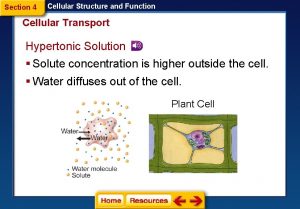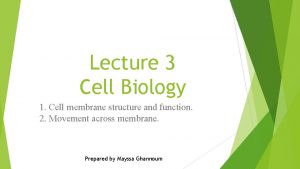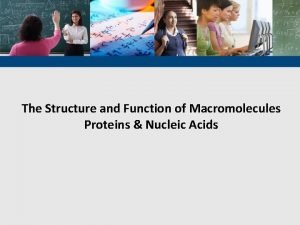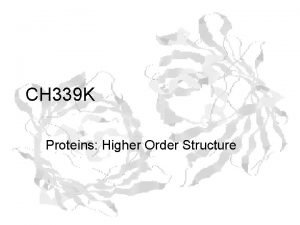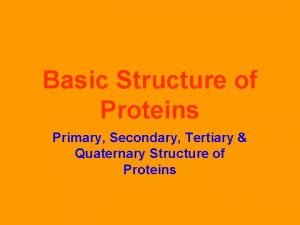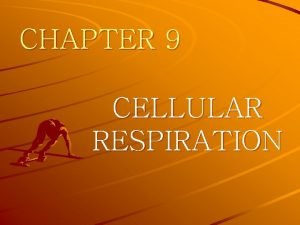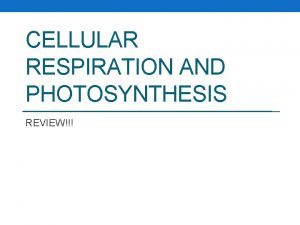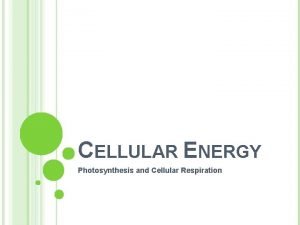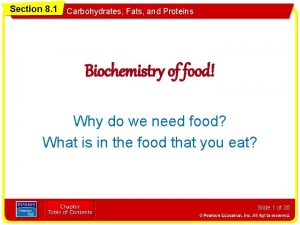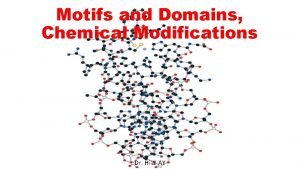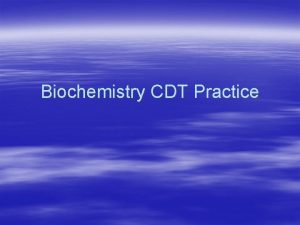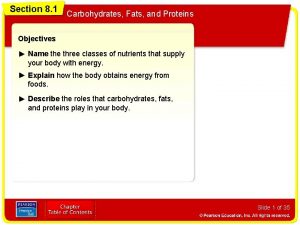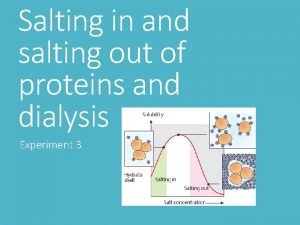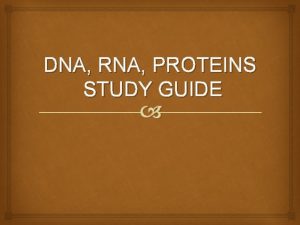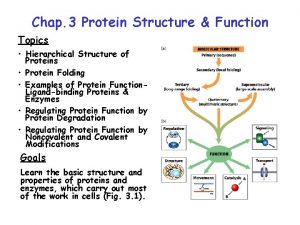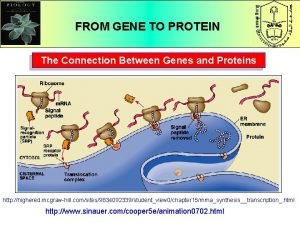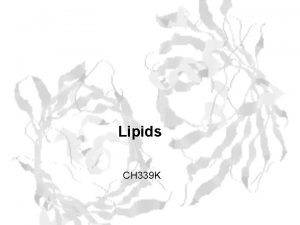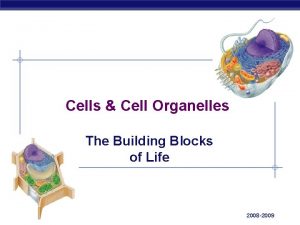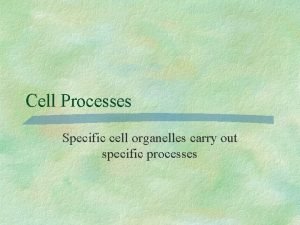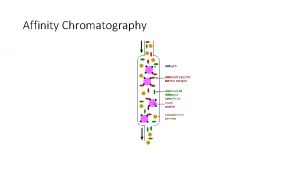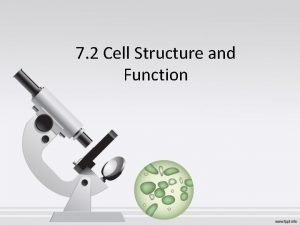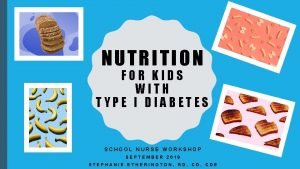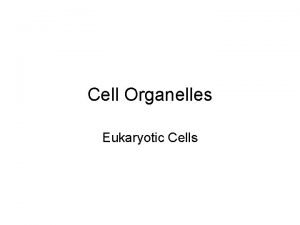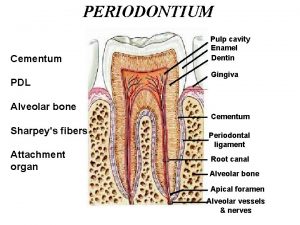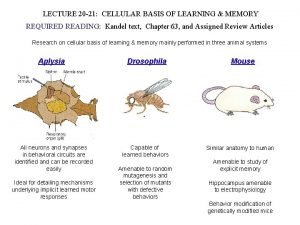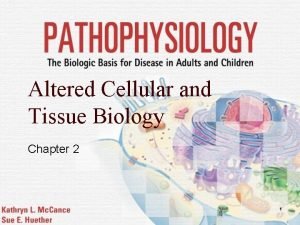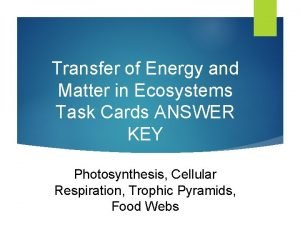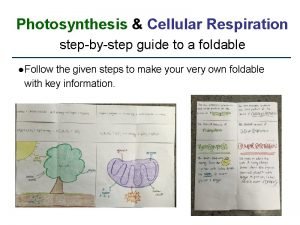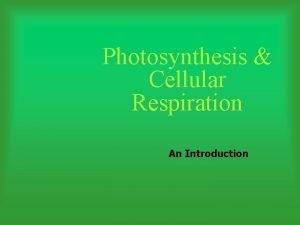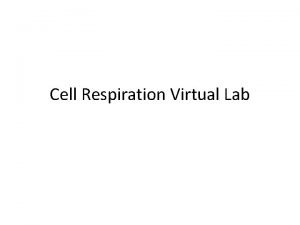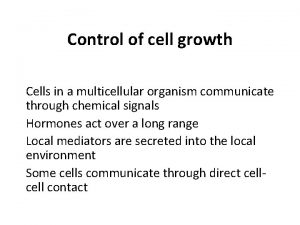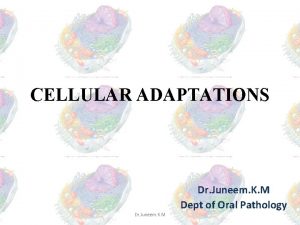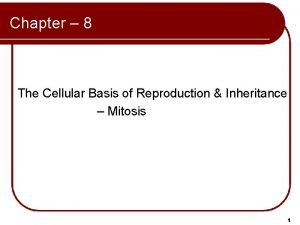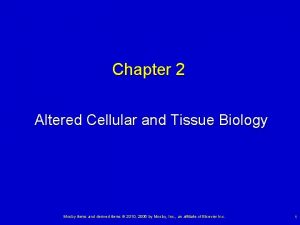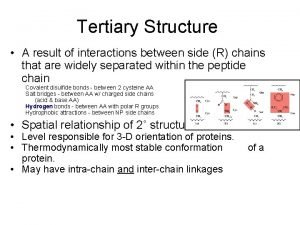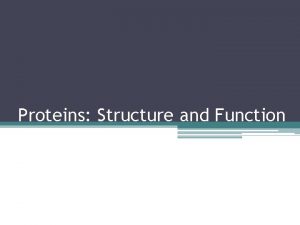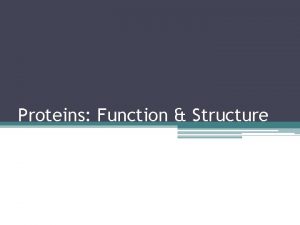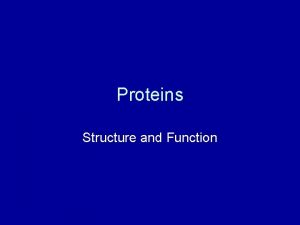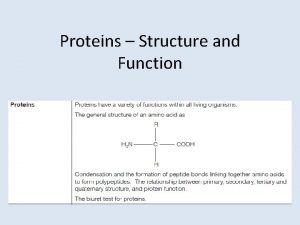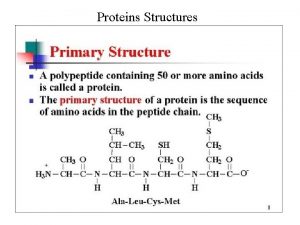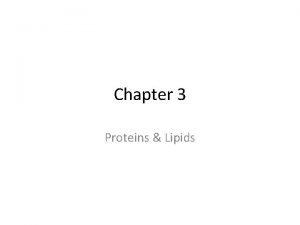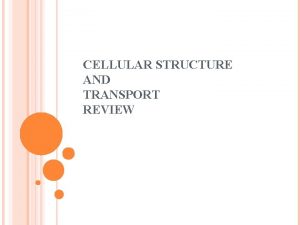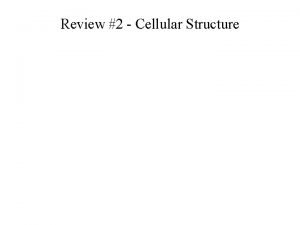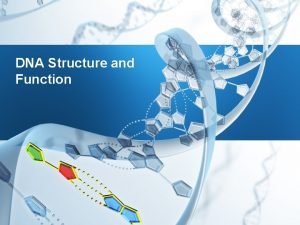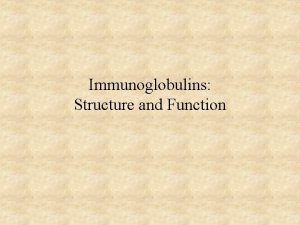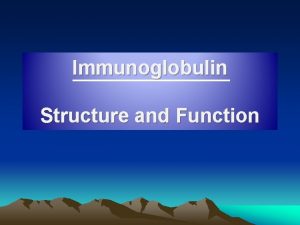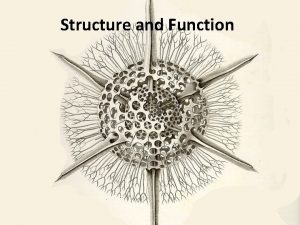Proteins Structure and Function Proteins 1 Cellular Overview

























































- Slides: 57

Proteins: Structure and Function

Proteins 1. Cellular Overview 1. Functions 2. Key Properties 2. Core Topics 1. Amino Acids: properties, classifications, p. I 2. Primary Structure, Secondary Structure, and Motifs 3. Tertiary Structure 1. Fibrous vs. Globular 4. Quaternary Structure

Amazing Proteins: Function 1. Catalysts (Enzymes) • The largest class of proteins, accelerates of reactions DNA Polymerase CK 2 Kinase Catalase 2. Transport & Storage Hemoglobin Serum albumin Ion channels Ovalbumin Casein

Amazing Proteins: Function 4. Structural Collagen Keratin Silk Fibroin 5. Generate Movement Actin Myosin

Amazing Proteins: Function 5. Regulation of Metabolism and Gene Expression Lac repressor Insulin 6. Protection Immunoglobulin Thrombin and Fibrinogen Venom Proteins Ricin

Amazing Proteins: Function 7. Signaling and response (inter and intracellular) Apoptosis Membrane proteins Signal transduction

Amazing Proteins: Properties • Biopolymers of amino acids • Contains a wide range of functional groups • Can interact with other proteins or other biological macromolecules to form complex assemblies • Some are rigid while others display limited flexibility

a-Amino Acids: Protein Building Blocks R-group or side-chain a-amino group Carboxyl group a-carbon

Synthesis of Proteins + H 2 O

Synthesis of Proteins

Synthesis of Proteins N-Terminal End C-Terminal End

Synthesis of Proteins = ≠

Synthesis of Proteins = ≠

Synthesis of Proteins ≠ ≠

COMMON AMINO ACIDS 20 common amino acids make up the multitude of proteins we know of

Amino Acids With Aliphatic Side Chains

Amino Acids With Aliphatic Side Chains

Amino Acids With Aliphatic Side Chains

Amino Acids With Aromatic Side Chains

Amino Acids With Hydroxyl Side Chains

Amino Acid with a Sulfhydryl Side Chain

Disulfide Bond Formation

Amino Acids With Basic Side Chains

Amino Acids With Acidic Side Chains and Their Amide Derivatives


There are some important uncommon amino acids

p. H and Amino Acids Net charge: +1 Net charge: 0 Net charge: -1

Characteristics of Acidic and Basic Amino Acids • Acidic amino acids ▫ Low p. Ka ▫ Negatively charged at physiological p. H ▫ Side chains with –COOH ▫ Predominantly in unprotonated form • Basic amino acids ▫ High p. Ka ▫ Function as bases at physiological p. H ▫ Side chains with N

Protein Structure We use different “levels” to fully describe the structure of a protein.

Primary Structure • Amino acid sequence • Standard: Left to Right means N to C-terminal • Eg. Insulin (AAA 40590) MAPWMHLLTVLALLALWGPNSVQAYSSQHLCG SNLVEALYMTCGRSGFYRPHDRRELEDLQVEQ AELGLEAGGLQPSALEMILQKRGIVDQCCNNI CTFNQLQNYCNVP • The info needed for further folding is contained in the 1 o structure.

Secondary Structure • The regular local structure based on the hydrogen bonding pattern of the polypeptide backbone ▫ α helices ▫ β strands (β sheets) ▫ Turns and Loops • WHY will there be localized folding and twisting? Are all conformations possible?

α Helix • First proposed by Linus Pauling and Robert Corey in 1951. • 3. 6 residues per turn, 1. 5 Angstroms rise per residue • Residues face outward

α Helix • α-helix is stabilized by H-bonding between CO and NH groups • Except for amino acid residues at the end of the α-helix, all main chain CO and NH are H-bonded

α Helix representation


β strand • Fully extended • β sheets are formed by linking 2 or more strands by H-bonding • Beta-sheet also proposed by Corey and Pauling in 1951.


PARALLEL ANTIPARALLEL

The Beta Turn (aka beta bend, tight turn) • allows the peptide chain to reverse direction • carbonyl C of one residue is H-bonded to the amide proton of a residue three residues away • proline and glycine are prevalent in beta turns

Mixed β Sheets

Twisted β Sheets


Loops

What Determines the Secondary Structure? • The amino acid sequence determines the secondary structure • The α helix can be regarded as the default conformation – Amino acids that favor α helices: Glu, Gln, Met, Ala, Leu – Amino acids that disrupt α helices: Val, Thr, Ile, Ser, Asx, Pro

Can the Secondary Structure Be Predicted? • Predictions of secondary structure of proteins adopted by a sequence of six or fewer residues have proved to be 60 to 70% accurate • Many protein chemists have tried to predict structure based on sequence ▫ Chou-Fasman: each amino acid is assigned a "propensity" forming helices or sheets ▫ Chou-Fasman is only modestly successful and doesn't predict how sheets and helices arrange ▫ George Rose may be much closer to solving the problem. See Proteins 22, 81 -99 (1995)


Tertiary Structure • The overall 3 -D fold of a single polypeptide chain • The amino acid sequence determines the tertiary structure (Christian Anfinsen) • The polypeptide chain folds so that its hydrophobic side chains are buried and its polar charged chains are on the surface ▫ Exception : membrane proteins ▫ Reverse : hydrophobic out, hydrophilic in • Driven by hydrophobic interactions • Stabilized by H-bonding, LDF, noncovalent interactions, dipole interactions, ionic interactions, disulfide bonds

Fibrous and Globular Proteins

Fibrous Proteins • Much or most of the polypeptide chain is organized approximately parallel to a single axis • Fibrous proteins are often mechanically strong • Fibrous proteins are usually insoluble • Usually play a structural role in nature

Examples of Fibrous Proteins • Alpha Keratin: hair, nails, claws, horns, beaks • Beta Keratin: silk fibers (alternating Gly-Ala-Ser)

Examples of Fibrous Proteins • Collagen: connective tissuetendons, cartilage, bones, teeth ▫ Nearly one residue out of three is Gly ▫ Proline content is unusually high ▫ Unusual amino acids found: (4 -hydroxyproline, 3 hydroxyproline , 5 hydroxylysine) ▫ Special uncommon triple helix!

Globular Proteins • Most polar residues face the outside of the protein and interact with solvent • Most hydrophobic residues face the interior of the protein and interact with each other • Packing of residues is close but empty spaces exist in the form of small cavities • Helices and sheets often pack in layers • Hydrophobic residues are sandwiched between the layers • Outside layers are covered with mostly polar residues that interact favorably with solvent

An amphiphilic helix in flavodoxin: A nonpolar helix in citrate synthase: A polar helix in calmodulin:


Quaternary Structures • Spatial arrangement of subunits and the nature of their interactions. Can be hetero and/or homosubunits • Simplest example: dimer (e. g. insulin) ADVANTAGES of 4 o Structures ▫ ▫ Stability: reduction of surface to volume ratio Genetic economy and efficiency Bringing catalytic sites together Cooperativity


Protein Folding • The largest favorable contribution to folding is the entropy term for the interaction of nonpolar residues with the solvent • CHAPERONES assist protein folding ▫ to protect nascent proteins from the concentrated protein matrix in the cell and perhaps to accelerate slow steps
 Cellular structure and function section 4 answer key
Cellular structure and function section 4 answer key Overview of cellular respiration
Overview of cellular respiration Aerobic respiration overview
Aerobic respiration overview Cellular respiration
Cellular respiration Cellular respiration
Cellular respiration Selectively permeable definition biology
Selectively permeable definition biology Structural proteins function
Structural proteins function Storage proteins function
Storage proteins function Higher order structure of proteins
Higher order structure of proteins Three peptide chains woven like a rope
Three peptide chains woven like a rope Food rich in nucleic acid
Food rich in nucleic acid Function of cellular respiration
Function of cellular respiration Function of cellular respiration
Function of cellular respiration Cellular respiration equation
Cellular respiration equation Section 8-1 carbohydrates fats and proteins answer key
Section 8-1 carbohydrates fats and proteins answer key Motifs and domains of proteins
Motifs and domains of proteins Organic compounds such as proteins and starches are too
Organic compounds such as proteins and starches are too What is the difference between hbv and lbv
What is the difference between hbv and lbv Section 8-1 summary carbohydrates fats and proteins
Section 8-1 summary carbohydrates fats and proteins Salting out proteins
Salting out proteins Secondary structure of protein
Secondary structure of protein Dna rna and proteins study guide answers
Dna rna and proteins study guide answers Protein structure
Protein structure What is the connection between genes and proteins
What is the connection between genes and proteins Integral and peripheral proteins
Integral and peripheral proteins Peptides and proteins
Peptides and proteins Endoplasmic reticulum factory part or worker
Endoplasmic reticulum factory part or worker Does exocytosis require energy
Does exocytosis require energy Mobile phase in affinity chromatography
Mobile phase in affinity chromatography Organelle that modifies sorts and packages proteins
Organelle that modifies sorts and packages proteins Diabetic food chart
Diabetic food chart What organelle ships proteins to the golgi apparatus
What organelle ships proteins to the golgi apparatus Functions of community
Functions of community Complementary processes
Complementary processes Photosyntehsis equation
Photosyntehsis equation Cementum
Cementum Ltp
Ltp Photosynthesis word equation
Photosynthesis word equation Mosby items and derived items
Mosby items and derived items Cellular events of acute inflammation
Cellular events of acute inflammation Cellular and molecular immunology
Cellular and molecular immunology Where does cellular respiration take place
Where does cellular respiration take place Cellular respiration foldable
Cellular respiration foldable Cellular transport and the cell cycle
Cellular transport and the cell cycle Edpuzzle cellular respiration
Edpuzzle cellular respiration Unicellular multicellular organisms
Unicellular multicellular organisms Photosynthesis and cellular respiration
Photosynthesis and cellular respiration Group technology and cellular manufacturing
Group technology and cellular manufacturing Cellular respiration virtual lab
Cellular respiration virtual lab Flocabulary photosynthesis read and respond answers
Flocabulary photosynthesis read and respond answers Cellular adaptation of growth and differentiation
Cellular adaptation of growth and differentiation Cellular adaptation of growth and differentiation
Cellular adaptation of growth and differentiation Photosynthesis and cellular respiration jeopardy
Photosynthesis and cellular respiration jeopardy Difference between somatic and molecular death
Difference between somatic and molecular death The cellular basis of reproduction and inheritance
The cellular basis of reproduction and inheritance Altered cellular and tissue biology
Altered cellular and tissue biology Protein pump vs protein channel
Protein pump vs protein channel Globular vs fibrous proteins
Globular vs fibrous proteins
